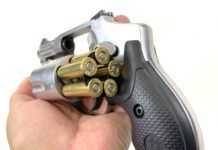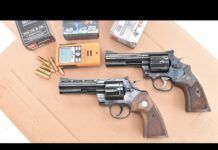In Cowboy Action Shooting, the targets are usually not especially hard to hit, but the action is very quick, which means a smooth, slick, easy-to-handle revolver gives the shooter an edge. Many shooters will want to get into the game with an “original” — a real Colt, but those sixguns are very expensive and pretty scarce, and those guns are not without their own special problems. But there are plenty of more recent choices in single-action revolvers, and we’ve tested quite a few. In the February 2006 issue, we called the Heritage Manufacturing Big Bore Rough Rider 45 Colt RR45B5, $379, a Best Buy when tested against a Taurus Gaucho SA45B 45 Colt, $499, which was a Don’t Buy model. In March 2005, we shot three more handguns chambered in 45 LC, the Ruger New Vaquero NV-455 No. 5101, $583; Beretta’s Stampede JEA1501, $540; and a retest of Cabela’s Millennium revolver, $280, with brass frame. We said the Millennium was a Best Buy, followed by the Stampede with a Buy It recommendation, and a Conditional Buy grade for the New Vaquero, which skipped two of the cylinders. In July 2003, we tested four more 45 Colt single actions, saying “Buy It” for the American Western Arms Peacekeeper, $835, and the Uberti Regulator, about $400. A Colt Single Action Army, about $1,700, got a Conditional Buy recommendation for its cost and troublesome operation. Our Pick of the test was a USFA Mfg. Co. Rodeo, about $500. More 45 Colts were tested in April 2001, with Cabela’s Millennium Revolver, $200, earning a Best Buy nod over a 1907 Colt SAA, about $1,500; and Ruger’s Bisley Vaquero, $450 (both Conditional Buys).
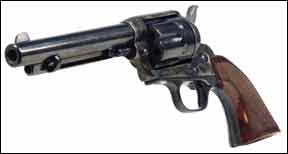
Many of these guns were interesting because they’re chambered in the more traditional 45 Long Colt, originally released in the blackpowder cartridge era of 1873-1890. Today, however, low-recoil loads help you go faster in SASS, and if your revolvers shoot 357 Magnums, you can buy a lever gun in the same caliber and shoot the same low-powder loads without having to worry about inserting the wrong shell. Way back in May 2000, we did test three “cowboy concealable” revolvers chambered for 357 Magnum, the EMF Hartford Sheriff’s Model ($365, Don’t Buy); the Cimarron New Sheriff ($469, Don’t Buy), and the Cimarron Thunderer ($489, Conditional Buy). It was far past time to update the smaller-bore single-action revolvers suitable for CAS, so we chose two reproduction Colts and Ruger’s New Vaquero, all chambered in the most common CAS competition caliber, 357 Magnum. Our choices were the Ruger New Vaquero NV-34 No. 5107, $719; the Heritage Manufacturing Big Bore Rough Rider RR357CH4, $500; and Cimarron’s Evil Roy No. ER4104, $770.
The Heritage and the Cimarron revolvers stayed true to the look of the Colt, with case-hardened frames and wood grips. The Ruger had a few modern innovations under the skin, as well as modern-looking black plastic grips and stainless screws. The overall sizes and weights were similar, with the major difference being the 5.5-inch barrel on the Cimarron Evil Roy, compared to the 4.6-inch-long barrel on the Ruger and the Heritage Rough Rider’s 4.75-inch barrel.
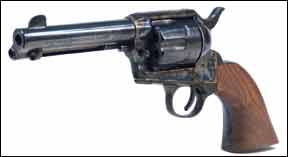
We tested all three for function and accuracy, shooting bench groups at 10 yards using a sandbag rest and two modern loads and one cowboy-action load. Though we looked at these guns first for their viability as fun guns being shot at the Big Hat Range, we also wanted to see how they’d handle contemporary rounds if pressed into other duties, such as self protection, plinking, or small-game hunting. The modern selections were Winchester USA’s WinClean 357 Magnum 125-grain load and the company’s 38 Special +P 125-grain choice. The cowboy action load was Black Hills Ammunition 38 Special Cowboy Action choice, with a 158-grain cast lead bullet. Here’s how our contestants fared:
Ruger New Vaquero NV-34 No. 5107 357 Magnum, $719
The New Vaquero is one of many single-action revolvers offered by Sturm, Ruger & Co. Inc., based out of Newport, New Hampshire. Available in blued and stainless finishes and barrels ranging from 4.62 to 5.5 inches in length, the manufacturer’s retail price remains the same regardless of finish, size, or caliber (357 Magnum or 45 Colt). Ruger offers Bisley and SASS Vaquero revolvers as well, but at higher MSRPs.
The Ruger Vaquero combines original Old West single-action looks and feel and adds new features. The mid-size steel frame and cylinder are scaled-down to the same size as the original 1955 Ruger Blackhawk, closely resembling the classic single-action revolvers of the late 1800s. The New Vaquero is a New Model single-action revolver, which means it utilizes the same mechanism as the Ruger New Model Blackhawk revolver.
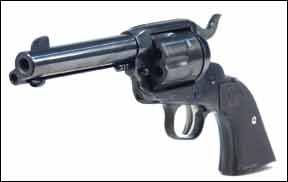
Our test gun measured 10 inches in overall length and 5.5 inches in overall height. The steel-frame pistol tipped the scales at 45.6 ounces unloaded and 48.2 ounces loaded. The blued steel barrel was 4.6 inches long, and the bore spun bullets with 8-groove, 1-in-16 right-hand rifling. The front strap and back strap measured 2.1 inches and 3.4 inches, respectively, and were bracketed by black-checkered rubber grips that measured 1.5 inches across and 5.8 inches around. The steel fixed rear-notch-front-blade sights were 5.5 inches apart. The trigger pull broke at 4 pounds, and when cocked, the trigger span was 2.6 inches. There was no external safety, but an internal safety sat hidden inside the grips.
Also, it incorporates an additional reverse indexing cylinder mechanism for ease of loading and reloading. On earlier Rugers, if the shooter rotated the cylinder until it clicked, the chamber was past the gate and had to be rotated all the way around to realign the chamber with the loading gate. The NV hammer has two positions, fully cocked and fully down. The loading gate can be opened only when the hammer and trigger are fully forward. Opening the gate immobilizes the trigger, hammer, and transfer bar. When the gate is opened, the cylinder is unlatched and can be turned for loading or ejection. When the gate is closed, the cylinder latch functions normally. The safe carrying position for the New Vaquero revolver is with the hammer fully down and the trigger forward. In this position the hammer does not contact the firing pin. In older (1953-1972) single-action revolvers, the hammer, when in the full forward position, does rest against the firing pin, so it should never be carried over a live round.
Those who shoot Ruger Vaqueros often replace the transfer bar system with a fixed firing pin hammer like the original Colts. The transfer bar is an important safety feature if you want to keep six rounds in the chambers, but for SASS you always leave the hammer on an empty chamber, and the gun is always pointed downrange.
The New Vaquero also has a grooved tip and a longer, more upswept hammer shape for easier cocking. The hammer spring has also been modified to allow for easier cocking. The Ruger and Rough Rider both required about 6.2 pounds of cocking force, compared to the Evil Roy at 5.25 pounds. We found that the large hammer on the Vaquero dug into our hand when fully cocked, although shooters with smaller hands will most likely not have that problem.
Cosmetically, the Ruger had a very dark blued-steel frame that had no finish mars or nicks. However, when our testers compared the NV’s rubber grips to the cocobolo and European walnut grips of the Heritage and the Cimarron, they ranked the Ruger a distant third in looks. Functionally, the checkered hard rubber grips presented sharp edges at the heel, which cut into our hands with the recoil of every shot. If the shooter wears gloves, then the panels probably wouldn’t need those edges knocked off. But the grips also didn’t fit perfectly, so sharp edges on the frame peeked out as well.
The action on this New Vaquero was very smooth, and the trigger pull released crisply at 4 pounds — heavy compared to the others. Part of that weight and a little balkiness in the initial trigger motion is due to moving the transfer bar upward so that it can contact the firing pin. But the .312-inch-wide smooth stainless trigger shoe was well radiused and felt comfortable, our testers said.
The Ruger was in the middle of the three revolvers for accuracy, something of a surprise. We expected this grip shape, first used on the 1851 Colt Navy revolver, to give the NV a pointing advantage. And Ruger machined in a half-moon trough under the sighting channel, which we thought might make the rear sight easier to read. And the NV’s barrel/cylinder gap measured a snug .003 inch. Yet, the Cimarron shot much better than the Ruger with two of the three ammo selections, and the third was a functional tie. The New Vaquero had its smallest group of 2.3 inches with the Winchester 38 Special +P, but the smallest average group size was 3.2 inches with the Black Hills Ammunition 38 Special Cowboy Action. Upside: Though the overall group size was larger with the Ruger, most of its shots were centered around the bull. We found differences in velocity were not large. The Vaquero shot the middle velocity for the 357 mag, and the lowest of the three revolvers with both types of 38 Special, although the differences are small.
The Vaquero had safety features not available on the other revolvers — mainly an internal lock inside the grips. This is a requirement in some jurisdictions, but we didn’t mess with it. The lock is hidden beneath the grip panels. The key has a built-in screwdriver to remove the right grip panel. Once the grip panel is removed, the key is inserted and rotated to lock the action.
Elsewhere, the shape of the ejector-rod button has been changed from a round to a crescent shape, which is both easier to use and better looking than the round button. But the button runs right alongside the barrel. After a full day of shooting, we had to be careful while ejecting not to burn our fingers on the barrel. The ejection rod and spring were smooth and operated well.
Our Team Said: The Ruger is a serviceable, reliable firearm. But our shooters didn’t like the non-period rubber grips, the hand-biting hammer, and the sharp edges on the frame and grips.
Heritage Manufacturing Big Bore Rough RiderNo. RR357CH4 357 Magnum, $500
Heritage assembles the Rough Riders in Opa Locka, Florida, with parts made by Pietta in Italy. The Rough Rider has a considerably lower price than both the Ruger and Cimarron, at $719 and $770 respectively, but that doesn’t mean we cut it any slack for form or function. It strongly resembles the Colt 1873 Peacemaker, and comes in 4.75-, 5.5-, and 7.5-inch barrel lengths. Heritage offers the Rough Rider in both 357 Magnum and 45 Colt with blued, case-hardened, and nickel finishes. Nickel costs the most, $550. Heritage also offers rimfire models of the Rough Rider and a small-bore centerfire 32 Magnum as well.
All varieties of the Big Bore Rough Rider come with the single-piece smooth cocobolo grips and fixed iron sights, front blade, and a rear notch. The Big Bore Rough Rider is an all-steel handgun with no alloy parts.
Our testers said its overall appearance was more like what they expected of a single-action revolver’s looks than the Ruger. The case-hardened finish and cocobolo grips give the overall look of a revolver a cowboy would be expected to carry. The Rough Rider uses the traditional safety method of a hammer block when the hammer is pulled back to the third click, just before fully cocked, along with the newer transfer bar for the hammer and firing pin. The smooth grips looked and felt good, but after a day of shooting outside in 90-degree weather, we had to use gloves because the grips got slippery.
We found the sight picture to be clear, but the gun comes with a notice from Heritage saying that it intentionally shoots low, so you should either aim high or file down the front sight, with the appropriate warning that overfiling the sight is an error that cannot be fixed.
Our main issue with the Rough Rider was the cylinder rotation while the hammer is in load/unload position. While trying to load or eject rounds, the cylinder rotation was loose, and would rotate too far or not far enough, causing the ejection rod to hit the cylinder instead of ejecting the round. We had to be vigilant about rotating and holding the cylinder while loading or unloading, which isn’t a problem if you’re shooting for fun, but a speedy ejection of shells and reload would be difficult, our testers said. The cylinder locked tightly while firing and showed no rotation problems, so the gun is perfectly safe. On the plus side of loading/unloading, unlike the Ruger, the Heritage ejection rod swiveled away from the barrel, so we had no worries about burning our fingers after a day of shooting.
At the range, the Rough Rider shot smoothly, with consistent groupings averaging just over 3 inches from 10 yards. However, because of the sights, our groups averaged about 6 inches low and out to 7 o’clock on all targets. Black Hills ammunition provided its smallest single group at 2.4 inches, while the Winchester 357 Magnum shot the smallest average at 3.2 inches. The Heritage produced the lowest velocity with the Winchester 357 round, but it placed in the middle for both of the 38 Special rounds.
Our Team Said: Overall, the Rough Rider shot good groups — but not to point of aim. As stated by Heritage this is intentional and can be modified, but we would rather avoid the hassle. Still, because of its lower price, there’s money left over to refine the action if that’s what you choose to do.
Cimarron Evil Roy No. ER4104 357 Magnum, $770
Cimarron Firearms’ Evil Roy is made by Uberti, the Italian maker of many replica brands of revolvers from the percussion age of the 1830s as well as cartridge guns from Colt, Marlin, Sharps, Smith & Wesson, Winchester, and into the early 20th Century. Out of the box, Uberti’s spaghetti wheelguns are popular among Single Action Shooting Society (SASS) competitors. But some shooters are willing to pay for a better product over the counter, and the Cimarron Evil Roy is the SASS-tuned version of the Uberti-made standard Model P single-action revolver, which is based on the 1873 single-action Colt Peacemaker.
It’s made to the specifications of world champion “Evil Roy” Gene Pearcey, who notes in his classes (EvilRoyShootingSchool.com), that SASS competition boils down to speed — hit all the metal plates as fast as possible. Among the speed improvements, the front and rear sights are slightly wider than normal, thus faster to acquire. Roy’s front sight measured 0.096 inch wide compared to the 0.090-inch-wide front sight on the Ruger and 0.1-inch-wide blade on the Heritage. Evil’s rear notch measured 0.142 inch wide compared to the Vaquero’s 0.138-inch width and the Heritage’s 0.115-inch notch width.
Internal tuning by the Cimarron gunsmiths became obvious when we started to shoot. The trigger was lightened to just 2 pounds, and the cylinder rotation was especially smooth for firing, loading and unloading. Our testers praised the smooth 0.125-inch-wide, lightened trigger, and they found that the Evil Roy shot to point of aim without adjusting the sights.
The slim checkered European walnut grips, case-hardened-color frame, and blued barrel give the Evil Roy an authentic look, while the tuning has it weighted well for a good feel. We had no functional issues with the Evil Roy: the hammer did not hit the webs of our hands, cylinder rotation was smooth, and the ejection rod swiveled away from the barrel like the Heritage, protecting our fingers from barrel burn. The fit and finish on this gun was excellent. The ejector rod lines up precisely with the loading trough for quick and easy loading, and the chambers easily released empty cases without sticking, even when firing hot magnum cartridges. There were no failures to fire with any load tested.
The Cimarron keeps the original Colt design with the firing pin on the hammer, which has been proven to fire if dropped directly on the hammer down on a loaded chamber. Like the Heritage, the Cimarron also employs a hammer block safety. To load, pull the hammer back halfway, which locks the hammer and trigger. The cylinder is locked, so open the loading gate and insert shells. To fire, pull the hammer all the way back to lock.
The Cimarron proved to be the most precise revolver in the test, showing both accuracy on target and consistent groups. With this gun, we shot the smallest single group and average group size with the Winchester .38 Special +P at 1.6 inches, and 1.9 inches respectively. The Evil Roy also shot the highest average velocity with all three types of ammunition.
Our Team Said: Each of the revolvers has its good points and its faults. The Ruger Vaquero has some modern innovations that make it less traditional, but potentially safer to keep around the house. Heritage’s Big Bore Rough Rider is a good value at 70% the price of the Ruger, but needs some smoothing. The Cimarron Evil Roy was our favorite because of the smooth function of the action and accuracy. But it is the most expensive of the three, and it lacks a transfer-bar safety, which is only a problem if the loaded pistol is dropped directly on the hammer over a live round.
0812-COWBOW-REV-ACC-CHRONO.pdf
0812-RUGER-NEW-VAQUERO-NV-34.pdf



























